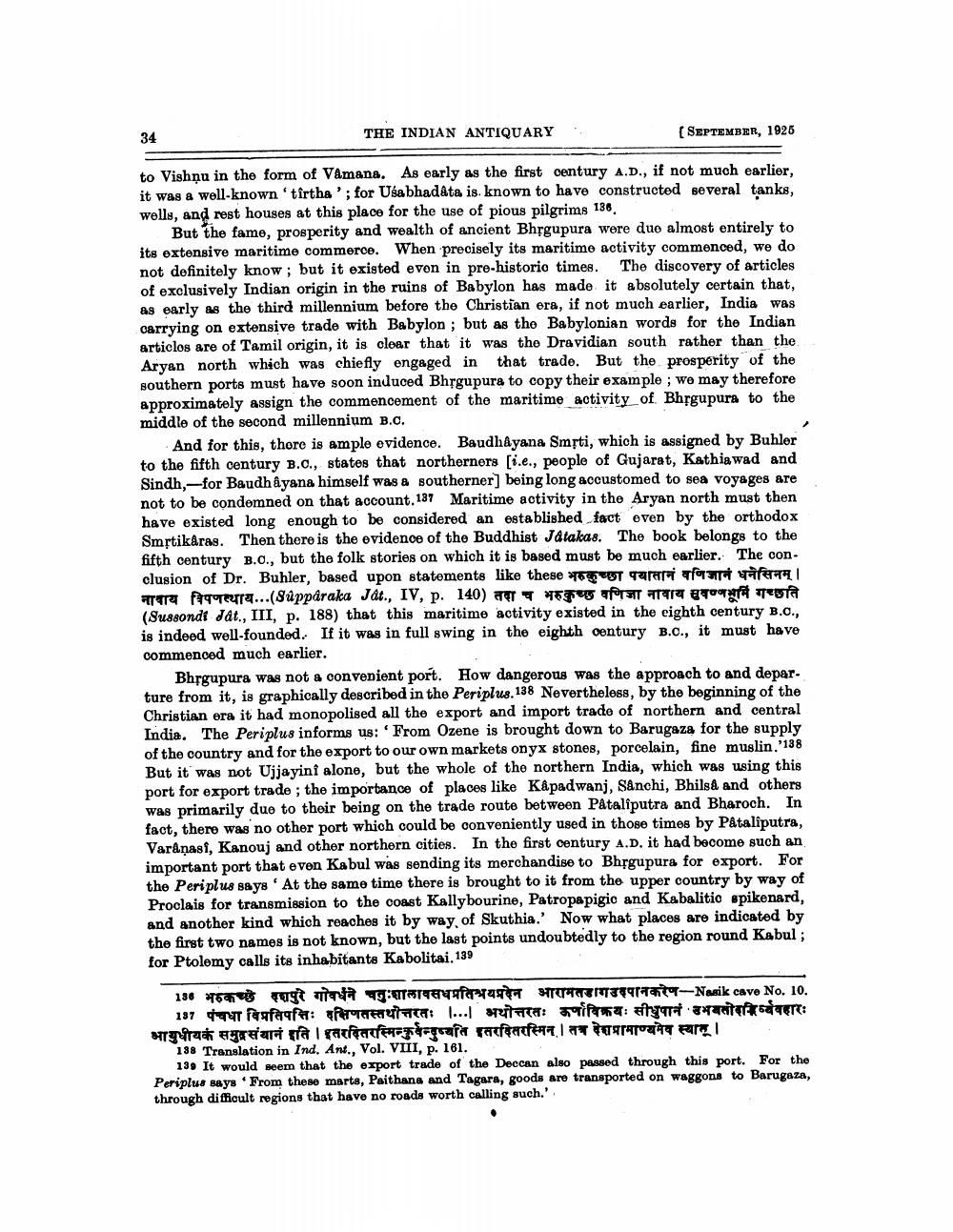________________
34
THE INDIAN ANTIQUARY
[SEPTEMBER, 1925
to Vishnu in the form of Vâmana. As early as the first century A.D., if not much earlier, it was a well-known 'tirtha'; for Usabhadata is known to have constructed several tanks, wells, and rest houses at this place for the use of pious pilgrims 136.
But the fame, prosperity and wealth of ancient Bhrgupura were due almost entirely to its extensive maritime commerce. When precisely its maritime activity commenced, we do not definitely know; but it existed even in pre-historic times. The discovery of articles of exclusively Indian origin in the ruins of Babylon has made it absolutely certain that, as early as the third millennium before the Christian era, if not much earlier, India was carrying on extensive trade with Babylon; but as the Babylonian words for the Indian articlos are of Tamil origin, it is clear that it was the Dravidian south rather than the Aryan north which was chiefly engaged in that trade. But the prosperity of the southern ports must have soon induced Bhṛgupura to copy their example; we may therefore approximately assign the commencement of the maritime activity of Bhrgupura to the middle of the second millennium B.C.
And for this, there is ample evidence. Baudhayana Smrti, which is assigned by Buhler to the fifth century B.C., states that northerners [i.e., people of Gujarat, Kathiawad and Sindh,-for Baudhâyana himself was a southerner] being long accustomed to sea voyages are not to be condemned on that account. 137 Maritime activity in the Aryan north must then have existed long enough to be considered an established fact even by the orthodox Smṛtikâras. Then there is the evidence of the Buddhist Jatakas. The book belongs to the fifth century B.C., but the folk stories on which it is based must be much earlier. The conclusion of Dr. Buhler, based upon statements like these rariff नावाय विपणस्थाय... (Sapparaka Jat, IV, p. 140 ) तदा च भरुकुच्छ वणिजा नावाय सुवण्णभूमिं गच्छति (Sussondi Ját., III, p. 188) that this maritime activity existed in the eighth century B.C., is indeed well-founded. If it was in full swing in the eighth century B.C., it must have commenced much earlier.
Bhrgupura was not a convenient port. How dangerous was the approach to and depar ture from it, is graphically described in the Periplus. 138 Nevertheless, by the beginning of the Christian era it had monopolised all the export and import trade of northern and central India. The Periplus informs us: From Ozene is brought down to Barugaza for the supply of the country and for the export to our own markets onyx stones, porcelain, fine muslin.'138 But it was not Ujjayini alone, but the whole of the northern India, which was using this port for export trade; the importance of places like Kapadwanj, Sânchi, Bhilså and others was primarily due to their being on the trade route between Pâtaliputra and Bharoch. In fact, there was no other port which could be conveniently used in those times by Pâtaliputra, Varanasi, Kanouj and other northern cities. In the first century A.D. it had become such an important port that even Kabul was sending its merchandise to Bhrgupura for export. For the Periplus says At the same time there is brought to it from the upper country by way of Proclais for transmission to the coast Kallybourine, Patropapigic and Kabalitic spikenard, and another kind which reaches it by way, of Skuthia.' Now what places are indicated by the first two names is not known, but the last points undoubtedly to the region round Kabul; for Ptolemy calls its inhabitants Kabolitai, 139
130 भरकच्छे दशपुरे गोवर्धने चतुःशालावसधप्रतिश्रयप्रदेन आरामतडाग उदपानकरेण - Nasik cave No. 10. 137 पंचधा विप्रतिपत्तिः दक्षिणतस्तथोत्तरतः ।... अथोत्तरतः ऊर्णाविक्रयः सीधुपानं उभयतोदद्भिर्व्यवहारः आयुधीयकं समुद्रसंयानं इति । इतरदितरस्मिन्कुर्वन्दुष्यति इतरदितरस्मिन् । तत्र देशप्रामाण्यमेव स्यातू ।
138 Translation in Ind. Ant., Vol. VIII, p. 161.
139 It would seem that the export trade of the Deccan also passed through this port. For the Periplus says From these marts, Paithana and Tagara, goods are transported on waggons to Barugaza, through difficult regions that have no roads worth calling such.'




